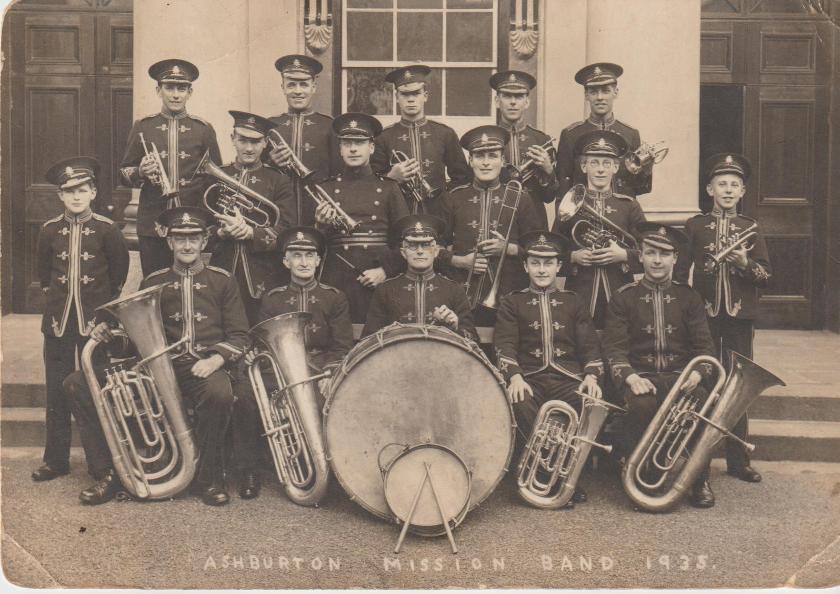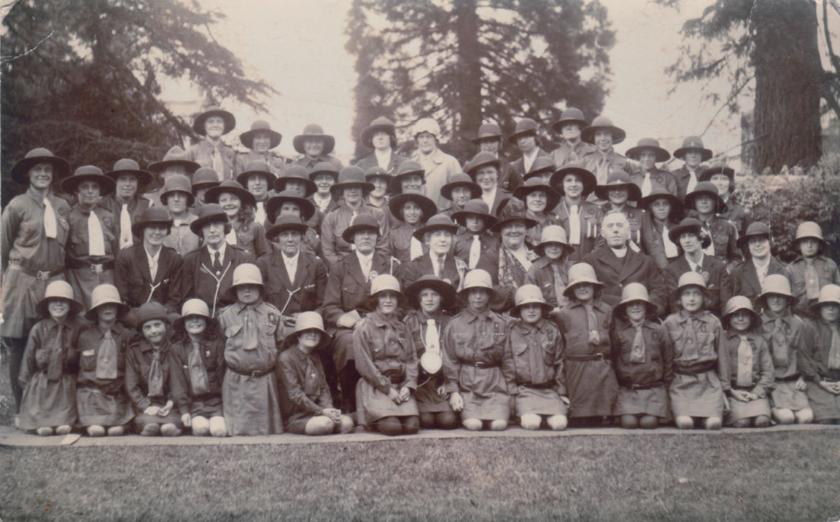

Join the Club - Organizations and societies
The St John Ambulance Association, formed to train the public in first aid, was established in 1877.
1902 Devon had centres at Plymouth, Uffculme, Ashburton, Newton Abbot and Exeter. Newton Abbot had been first in 1895. William Jewell, superintendent of the Newton Division, stated that Newton now had 86 members, wiith Ashburton a 'poor second' with 13.
Exeter and Plymouth Gazette 22 July 1902 p7 col3
Exeter and Plymouth Gazette 3 October 1904 p3 col3
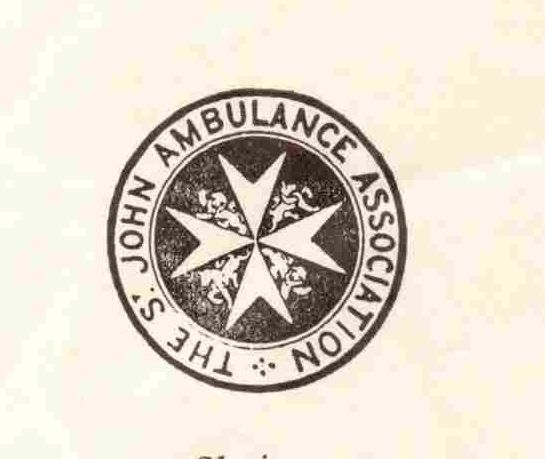
When W T Butchers died in 1927, he was described as the founder of the local St John Ambulance Brigade.
Western Times 14 October 1927 p2 col6
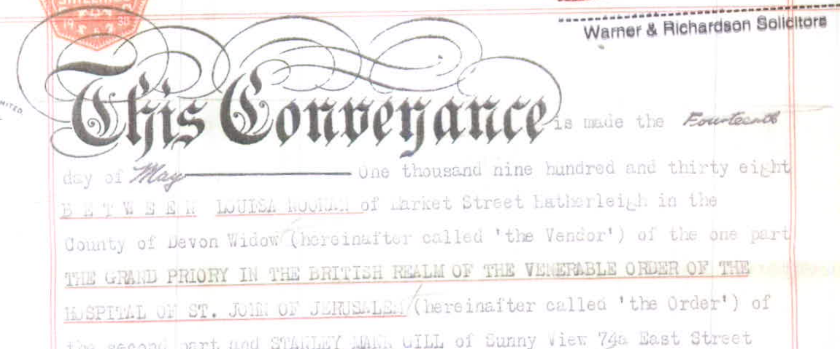
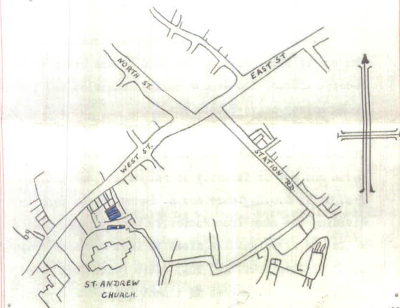
1939 The new headquarters of the Ashburton St John Ambulance Brigade was opened. Four cottages, condemned as unfit for human habitation, had been converted into the new hall and offices.
Ashburton Brigade and the Cadet Division were said to be the second oldest in Devon.
Exeter and Plymouth Gazette 21 April 1939 p16 col2
At the outbreak of war the hall was designated a first-aid post, and individuals were given specific responsibilities in case of air raids.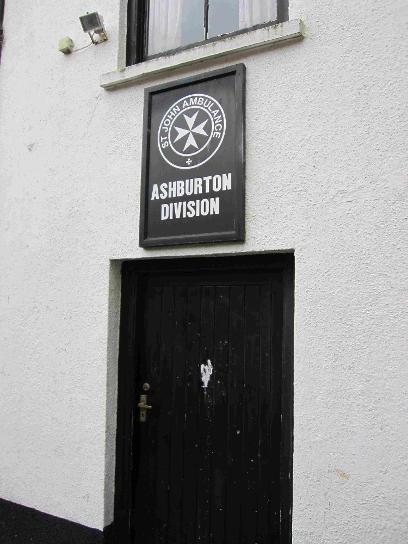
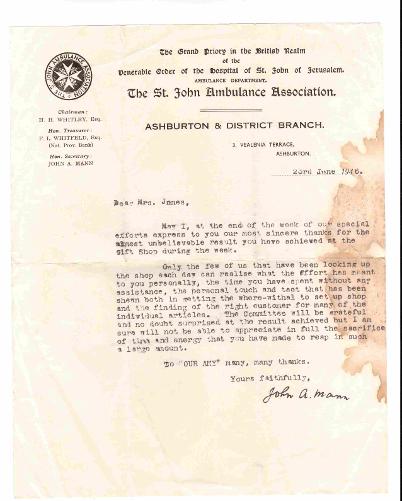
''Patients were conveyed to the local hospital in what I can only describe as an elongated perambulator. It had a brown canvas hood and cover and was pushed by two St John Ambulance men. It can still be seen in the St John Ambulance Hall today.'
Reminiscences of Hazel Bray, to whom many thanks.
1948 Ashburton Division's first ambulance was dedicated in the Bullring by the vicar, the Rev G A B Jones. H H Whitley was chairman of the Ashburton Association. J A Mann said that when the new Health Act* came into force the ambulance would remain the property of the St John organization.
Western Times 28 May 1948 p3 col4
* The act that brought in the National Health, which came into being two months later.
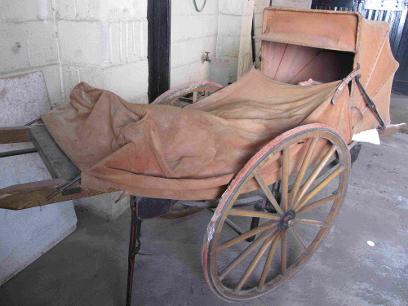
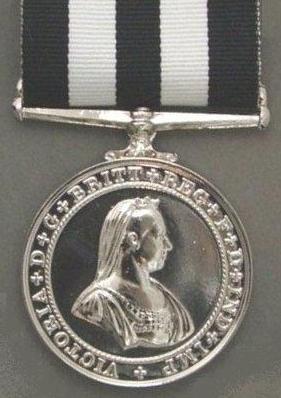

The Library
The subscription library, 'one of Ashburton's oldest institutions', was established in 1831 at the house of Mr Joseph Fitze, later the Registrar of Births and Deaths.
Western Times 20 April 1916 p13 col1
Before this, however, there was a Library Society, established in 1825 but on the brink of being dissolved in early 1830, when shareholders were to meet 'at the library' on the 18th February. W E Stentiford was secretary at the time.
Exeter and Plymouth Gazette 30 January 1830 p1 col2
Joseph Fitze, saddler, is living in East Street at the time of the 1861 census
http://www.freecen.org.uk/
For a portrait of Joseph Fitze, see the 1860s section of the Virtual museum.
On the 1901 census John Peter Foot is a bootmaker in East Street, living with his wife Elizabeth.
He died at The Library, a month after the census, aged 85
http://ancestry.co.uk
Western Times 2 May 1901 p1 col1
In 1903 Mr W T Butchers, the headmaster of the board school, 'deplored' the fact that there was no library* for the people of Ashburton. Speaking at the Mutual Improvement Society, he said that he would rather young people read nothing at all rather than the 'trash' that they currently got hold of.
Western Times 19 March 1903 p3 col5
*ie a free one
At a ratepayers' meeting in 1905 it was noted that a Mr Carnegie had been consulted over a free library, which might be achieved if a penny rate was adopted.
Western Times 20 June 1905 p3 col6
Mrs J P Foot is the librarian in the Ashburton, Buckfastleigh, Brent and Ivybridge Almanac 1906.
Subscriptions dwindled during the First World War, and the books were then offered to the Governors of the Grammar School, on condition that the public could have access once a week. This resolution was adopted on 15th April 1916, with Miss May Tucker being elected librarian.
Western Times 20 April 1916 p13 col1
'The Old Library' is now No 49, East Street
When James Mortimer, a former headmaster of the Grammar School, died in 1929, the Old Ashburtonian Society appealed for money to fund a scholarship in his name.
The fund closed in December 1932, but as there was insufficient money to provide a scholarship a plan was formed for the refurnishment of the Library. The work was carried out during the following summer, and there was a formal opening in September. 'A new oak floor was laid and the somewhat ugly fireplace replaced by a modern grate with an oak mantelpiece and surround. In addition, the library was furnished with two large oak refectory tables and twenty two chairs.' A large photograph of James Mortimer was hung above an inscribed tablet.
Ashburton Grammar School 1314-1935, W S Graf, Ashburton 1938, pp 31 and 36.
1942. During the Second World War Devon County became involved in the library when a new branch of the Devon County Library opened in Ashburton. Up until that point volunteers had maintained the library with money subscribed from all over the world by old boys. The county library scheme had been in operation for 17 years, and the Chairman of the Devon County Library Committee said that books played a valuable part in keeping up public morale.
The library was located in the library room of the old Grammar School.
Western Morning News 15 October 1941 p5 col5
Exeter and Plymouth Gazette 15 May 1942 p6 col5
Exeter and Plymouth Gazette 29 May 1942 p5 col2
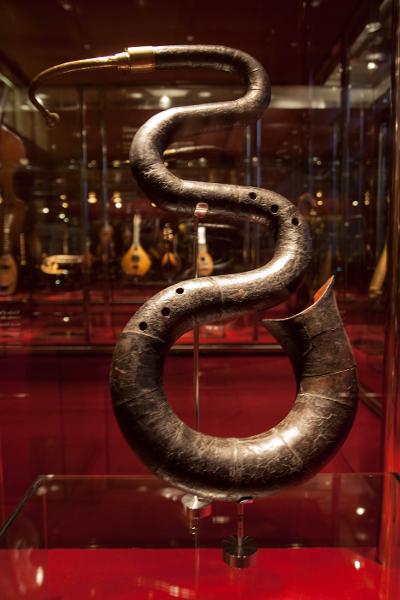
The Church Band may have been separate from the amateur band.
John Waycott, aged 53*, died in September 1846. He was described as formerly being a member of the Amateur Band.
Western Times 17 October 1846, p5 col2
The Exeter and Plymouth Gazette said that he was 45
A thief stole a clarionette, belonging to the Town Band, from H Foot, West Street. He was captured at Exeter.
Exeter Flying Post 4 January 1849 p8 col4
When William Popelstone, a rope manufacturer, died at Ashburton, he was described as being a member of the Ashburton Band for many years. He was 59.
Western Times 8 December 1855, p5 col3
******
The Ashburton Farmer's Club
1847 Intending members of the Ashburton Farmers' Club were invited to Bracewell's London Inn on alternate Saturdays. Meetings were to begin in January, with Dr. Soper delivering the first lecture on agricultural chemistry. The committee included John Berry, Solomon Tozer, John S. Amery, John King, W. R. Whiteway, William Widger, John Hext, Richard Searle and others.
Exeter and Plymouth Gazette 27 November 1847 p4 col4
In 1848 there were plans for a ploughing match.
Mr W R Whiteway, seed merchant, had shown some new implements at a recent fair. Some 'extraordinary mangel worzel and turnips' had 'excited unusual interest'.
Western Times 18 November 1848 p5 col5
1849 The Ashburton Farmer's Club held its first anniversary dinner at Bracewell's London Inn.
Exeter Flying Post 4 January 1849 p8 col4
*******
The Ashburton and South Devon Geological and Mineralogical Society
The rules of the society (1850) are held at the Devon Heritage Centre, ref QS/56/23
******
The Ashburton Mutual Improvement Society.
1851 A large number of people attended the lecture by the Rev J Dore on the use of globes.
Western Times 22 November 1851 p7 col5
John Dore, a Baptist minister, is living with his wife Mary, son and daughter in East Street on the 1851 census. Aged 59, he was born in Lymington, Hampshire.
1851 census Class: HO107; Piece: 1871; Folio: 290; p8
The Mutual Improvement Society became dormant after the 1916-17 session, on account of the First World War; at the time there were 49 members. When meetings resumed in 1920. Mr J H Mitchelmore presented the report for that last session, and said that all those members who had joined the armed forces had returned safely from the war with the exception of Wilfred Evans, a past president and hon. secretary.
Western Times 5 November 1920 p9 col2
******
The Ashburton Madrigal and Glee Club
1854 saw the club's fourth public performance. The Western Times was complimentary, harking back to a time when music 'was more cultivated' than modern 'trashy compositions' and was regarded as an important part of education.
Western Times 30 March 1850 p7 col5
In 1855 the Musical Times said the Madrigal Society had been in existence for forty years.* '[It] is at present progressing favorably, and was augmented on the 11th May to the number of twenty-one members, with H Caunter Esq. as their President.'
The Musical Times, vol7 1855, London, p28
*Four?
******
The Rifle Volunteers
Worried by the idea of an invasion of Britain, a slightly reluctant Government allowed, in 1859, the formation of local groups of volunteers, to defend the country if necessary. Arranged by county, they were formed into companies and battalions.
Review of 'Tracing the Rifle Volunteers, a Guide for military and family historians', by Ray Westlake, on http://dalyhistory.wordpress.com
'Almost every town in Devon (held) meetings for the purpose of forming corps'
The Ashburton and Buckfastleigh Corps was 'accepted' (by Queen Victoria) on the 25 February 1860 as the 9th Devon R. V.
The Haytor Volunteers, Their history and development, Lieut Col Amery, rep from the Totnes Times and Western Guardian 1888, pp19,20
9 months after it was formed, a bazaar was held in the new Market Hall to raise funds. Items on the stalls included lace, embroidery, stuffed birds and lithographs. One stall attracted particular attention - it consisted of fresh game birds, including a rare one shot on Dartmoor.
Exeter and Plymouth Gazette 6 October 1860 p7 col1
1864. J H Astell M. P. gave the 9th Devon R. V.£20 towards new uniform.
Ashburton ladies were planning a 'fancy bazaar' to raise funds for the corps.
Exeter Flying Post 23 March 1864 p3 col6
About 1865 the whole Battalion was clothed alike in slate grey with scarlet facings, and black belts.
The Haytor Volunteers, Their history and development, Lieut Col Amery, rep from the Totnes Times and Western Guardian 1888, pp19,20
1869 George Rowlands, a member of the Volunteers, had to have his foot amputated after a gun accident (not necessarily connected to the Volunteers). Corporal Edgecumbe started a collection for the young man, and £7 12s 6d was raised.
Exeter and Plymouth Gazette 9 October 1869 p4 col1
In the 1871 census 25 year old John S[parke] Amery gives his occupation as Lieutenant in the Volunteers.
1871 census RG10 piece no 2080 folio 21 p19
In 1883 25 year old Richard Rowland died. The youngest son of John Rowland of Lower Headborough, he was a private in the Volunteer Corps. He was buried in Ashburton churchyard, with a procession which included a firing party with reversed arms. They fired three volleys. Present were: Maj Amery, Lieut. Tozer, Lieut. Tuckers, Sergts Distin, Foot, Smerdon and Barnicott, Corporals Skinner and Maynard and forty rank and file. Richard was described as a 'promising shot'.
Western Times 2 October 1883 p5 col2
Western Times 5 October 1883 p7 col2
Western Times 16 August 1889 p2 col4
In 1891 the Devon County Volunteers Association held an annual shooting contest. The Class F Association Challenge Cup was won by Pte J Burch, Ashburton, who received a 'Plate and £7'.
The Exeter Flying Post 6 June 1891 p3
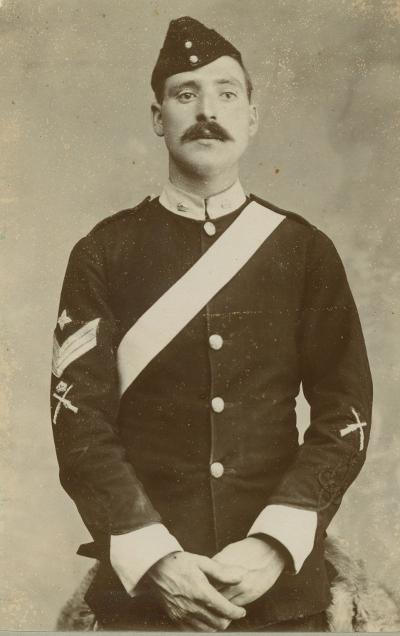
In
the 1901 census Frank Loveridge, aged 42, was the Colour Sergeant
Instructor of the Volunteers. He was living in St. Lawrence Lane.
1901 Census RG13, Piece 2053, Folio 5, p2
When
he died in 1920 he was described as the holder of various medals,
including the Afghan medal of 1878-79-80. He had also served in India
with the 2nd Devons.
Western Times 21 May 1920 p8 col1
See The Rifle Volunteers in the main menu for Dave Dycher's research.
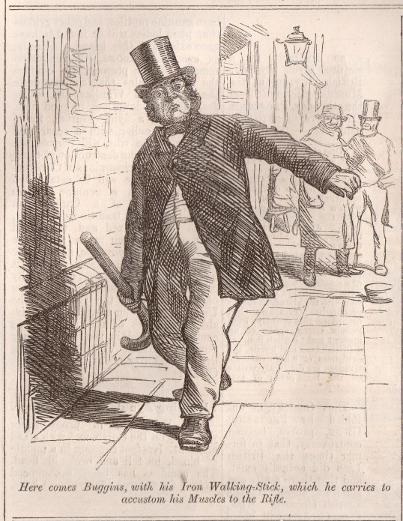
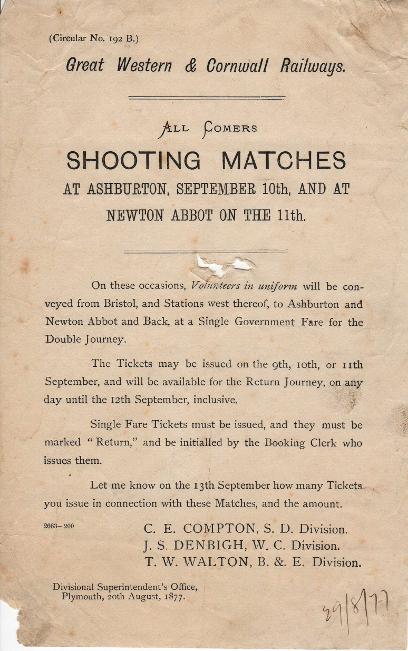
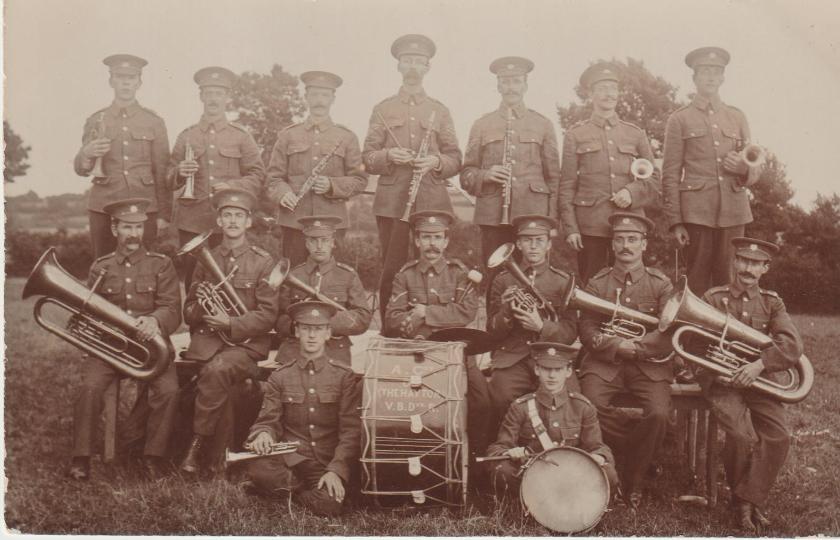
*******
Registrar of Friendly Societies in England
Amicable Society, established Ashburton, Devon, Midsummer session 1829
Accounts and papers, Private bills, Friendly Societies, Poor Laws (Ireland) etc., vol13, 31 Jan-17 July 1837, p6
Dissolution of the Ashburton Provident Tradesmen's Friendly Society, held at the Duke's Head Inn, Ashburton
London Gazette Issue 22731 1 May 1863, p2326
The Ashburton Union Society, (a Friendly Society), held at the London Inn, West Street, was dissolved in February 1883
London Gazette Issue 25206 2 March 1883, p1187
The Ashburton Institute
The Ashburton Institute 'established chiefly for the working classes' opened in St Lawrence Street in October 1878.
Financed by voluntary subscription and charges (working men paid 1d weekly, others 2d), it provided reading, smoking, recreation and refreshment rooms. Newspapers and magazines were provided.
Housekeeper - Mrs Whiddon
Secretary - J Mortimer
Treasurer - J Bickford
White's History, Gazetteer and Directory of Devon, 1878-79,p14
In March 1881 Dr Adams read a paper on Cremation at the Institute. This was followed by a discussion on the proposal that, 'Cremation, from a sanitary point of view, is the best mode of disposing of the dead, and with due safeguards should be permitted in this country.'
Western Times 1 March 1881, p6 col1
At the beginning of the winter season an exhibition was held on the subject of home and foreign travel. The Messrs Amery contributed pictures of ancient forms of travel; Dr. Adams brought his microscope, graphoscope and specimens including coral, Dead Sea stone and cedar wood; Dr. Fraser displayed Indian hand paintings; and the Rev. W M Birch brought a stereoscope and a number of views. Mr. Clymo contributed an Australian whip to the exhibition, and Mr. Mortimer showed a case of stuffed birds from Queensland. There were many more exhibits, plus demonstrations. The Messrs. Amery 'caused much merriment with their experiments on their galvanic battery.'
Western Times 26 November 1881 p4 col3
In 1880 Mr Tanner suggested that a Field Club be established. Mr E F Tanner (presumably the same Mr Tanner) also offered £20 to start a library in connection with the Institute.
Exeter and Plymouth Gazette 4 May 1880 p4 col3
The second meeting was in June, when Mr Fabyan Amery led a group up to Blackslade Down. Topics included during the walk included a discussion on peat, and speculation on who inhabited the Down.
Western Times 11 June 1880 p8 col2
Right: The Field Club visiting Druid Mine.
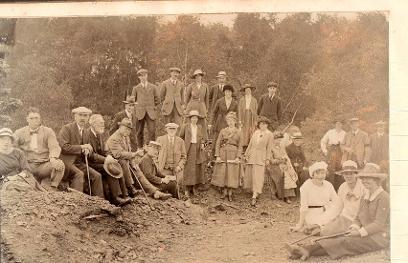
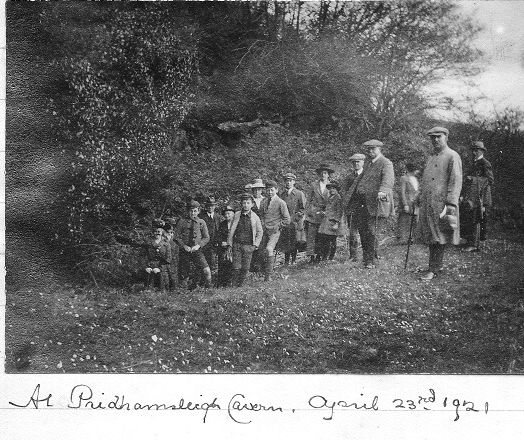
In May a group went by train to Buckfastleigh, with Mr. Fabyan Amery as leader. They visited the parish church, the Brook and Wheal Emma mines, Hawsen Court, Buckfast Abbey and Dart Bridge.
Western Times 28 May 1880 p8 col4
*******
The Field Club lapsed, but was revived in 1921, after a gap of 'thirty or forty years.'
Anonymous newspaper article, 21 April 1921 handwritten alongside.
Thanks to Lerida Arnold for the above.
Left: The Field Club in 1921, visiting Pridhamsleigh.
The group went up to Whiddon Scrubbs, beginning at North Street. Ancient tin workings were observed at Waterleaf* Bridge.
J S Amery gave a talk on the cuckoo, incorporating the latest discoveries made by Edgar Chance**.
Western Times 26 May 1922 p10 col1
* Surely must be Waterleat Bridge
* *Edgar Chance, a dedicated ornithologist, produced a film called The Cuckoo's Secret, which changed people's perception of how the bird reproduced.
http://www.wildfilmhistory.org/film/296/ Accessed 13-10-2013
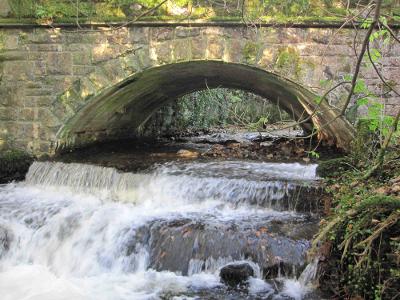
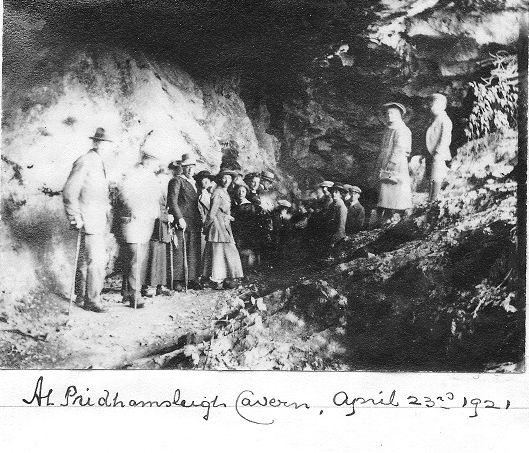
54 members and friends went to Fingle Bridge in September 1923.
J Mortimer gave a talk comparing the Dart and the Teign.
Western Times 14 September 1923 p7 col4
1924 The Field Club visited Buckland Beacon.
Mr J F Baker gave a paper on William Gifford and Dr. Cooksley
Western Times 4 July 1924 p11 col2
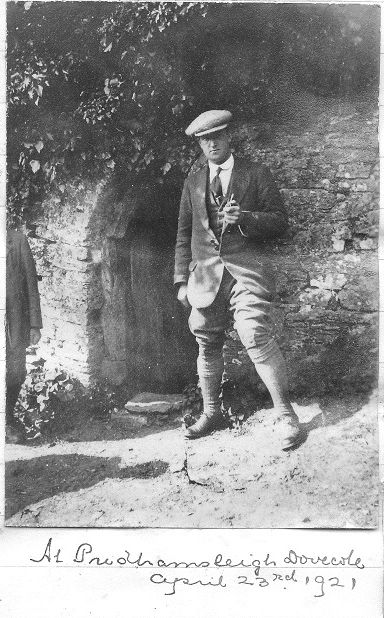
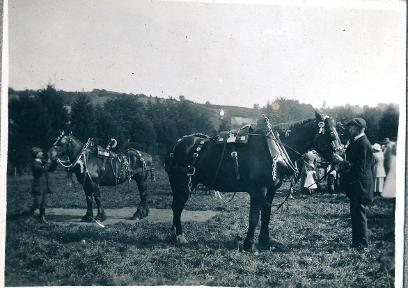
The Ashburton Lodge received its warrant of
Constitution in 1886, and received its lodge number - 2189 - from 1894
onwards*. Meetings were held from 1887 at the Commercial Hotel, North Street.
Lane's Masonic Records 1717 - 1894 http://www.hrionline.ac.uk/lane/
* The item below contradicts this date
The Commercial Hotel is presumably the same as The Commercial Inn documented by Pete Webb (The Pubs and Inns of Ashburton 1995 page 8), located at 7 North Street.
In 1890 the Ashburton Lodge moved to The Masonic Hall, Chuley Road.
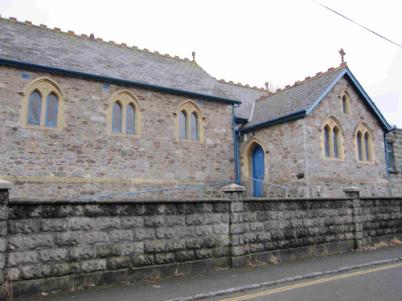
Inscription: This foundation stone of the Ashburton Lodge no. 2189 of A F and A Masons was laid on the 8th (?) day of December 1889 by W Bro the Hon R M W Dawson P M ? Prov C S W Devon Founder and duly proved by Bro Walter S Gervis M D W M Founder ? site Bro H Stevens Treas Founder
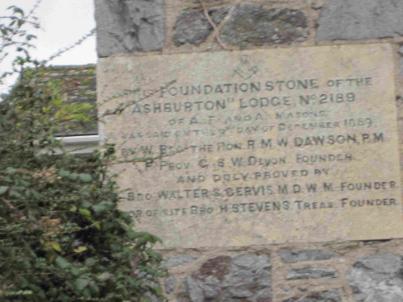
In 1906, at
the funeral of John Berry*, a newspaper report stated ' The Freemasons,
wearing sprigs of acacia, headed the mournful procession...'
*Died 15th June 1906
Unknown newspaper article. Many thanks to Richard and Frances Berry for this item.
In 1945 the
Ashburton Lodge of Mark Master Masons, number 1038, was founded and
consecrated. In November 1946 the retiring Master was W Bro M H Needham,
Prov G Chap. Bro E. O. Babbington was installed for the coming year
Western Times 22 Nov 1946 p5 col 6
The Liberal Club
http://discovery.nationalarchives.gov.uk - Accessed 14-1-2014
In 1888 the Liberal Association was meeting in Kingsbridge House
Western Times 21 February 1888 p7 col3
The 1911 census shows 32 year old Susan Luscombe as the club caretaker at Kingsbridge House - she is living there with her two children
Old Age Pension Day was celebrated by a social gathering at the club. Congratulatory messages were sent to Mr Asquith during the evening on the success of the Old-age Pensions Act.
Western Times 4 January 1909 p4 col6
In April 1913 the Liberal Club moved from its old premises in Kingsbridge Lane to new ones in North St, formerly the Commercial Inn* Bought for £386, the property had been renovated to provide 2 billiard rooms, a bagatelle room, and rooms for reading and cards, in addition to the caretaker's apartment. The chairman commented that if 'Old Mr Andrews could rise up and see his hotel used as a Liberal Club, he did not know what he would say (laughter)'.
Western Times 18 April 1913 p11 col4
* 7 North St - the newspaper item has a photograph.
Mr John Cornish, Woodland Road, appointed caretaker
Western Times 26 February 1915 p10 col1
******
The Ashburton Mutual Improvement Society
In August 1881 the Mutual Improvement Society, together with some members of the Institute, went on an expedition to Castle Parks on Tower Hill. Mr F Amery put forward the argument for this being an ancient encampment before the group moved on to Ashburton Down, where Mr James Mortimer gave a talk on 'The effect of mountain scenery upon character.'
Western Times 5 August 1881 p8 col2
In 1883 the Rev. T N Oliphant as president. In October he gave a talk on the subject of 'Books'. J S and F Amery, R Eggbeer and J Batten were amongst those present.
Western Times 9 October 1883 p8 col6
'In my early days there was a Mutual Improvement Society in the town; it met during the winter months in the schoolroom of the Congregational Chapel. Special speakers would be invited and frequently those two scholarly brothers, Fabyan and John Amery, who show lantern slides of the various countries they had visited. It was an enlightening society.'
From the memories of Reg Andrews, born 1893.
Many thanks to Dave Hodge-Brooks and Ernie Smerdon.
The society sent congratulations to Queen Victoria on her 60th jubilee
London Gazette Issue 26872 13 July 1897, p3892
*******
The Oddfellows
At the funeral of John Down (see The Down and Beer families, in the sub-menu of People and Properties) the bearers were past Grand Masters of the Ashburton Loyal Lodge of Oddfellows. They were: Bros J Cock, A Hays, G Edgecombe, G H Andrews, W H Langler, W H Whiddon, J French and C H Baker. Other Oddfellows included C J Roberts, E Salter, F Oliver, E Winsor, H Boon, J H Pomroy.
Western Times 6 March 1913 p4 col7
The Ashburton branch was at this time 70 years old - about 40 members were about to form a lodge on March 3rd, 1845, assembling at Husson's Crispin Inn, North Street.
Western Times 1 Mar 1845 p4 col 3
Below: A letter from the Loyal Ashburton Lodge of Oddfellows, summoning members to the annual financial meeting of the lodge in February 1915. It is signed (Yours fraternally) by Charles H Baker, Secretary - presumably Highcross is his own address.
From my own collection
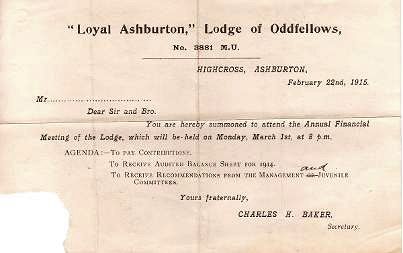
See also the medal presented to E Luscombe, in the 1930s section of the Virtual Museum.
A Juvenile Lodge was opened in April 1891, entitled 'The Pride of Ashburton'
Western Times 10 April 1891 p7 col2
******
The Constitutional Club
Arrangements were in hand during 1890 to build a Constitutional Club in St Lawrence Lane, on land belonging to Mr W Mann.
The new club was due to open on December 22nd 1890
Western Times 20 June 1890 p8 col5
Western Times 15 December 1890 p2 col5
The front of the Constitutional Club was decorated on 19th April to celebrate Primrose Day*.
Western Times 21 April 1891 p7 col3
*Primrose Day commemorated the death of Conservative statesman Benjamin Disraeli on April 19th 1881. Frank Bramley, a Newlyn painter, entitled one of his works in 1885 'Primrose Day'.
A copy of the Constitutional Club Library rules can be seen at Ashburton Museum
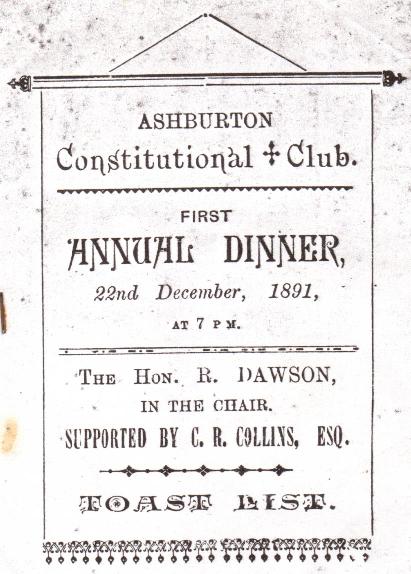
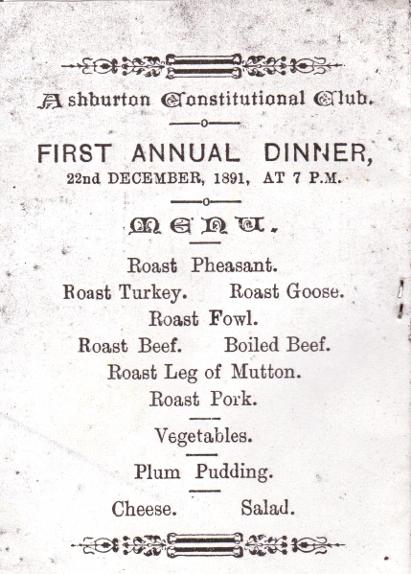
Many thanks to Richard and Frances Berry for the images above and right ******
15 members of the Constitutional Club who died in World War 1 were commemorated on a memorial, unveiled in 1922. Their names, carved and gilded, were inscribed on an oak tablet, which was hung in the billiard room, opposite the main entrance.
Western Times 11 August 1922 p5 col2
For a list of those who died, see the section Conflict, under Ashburton in Peril
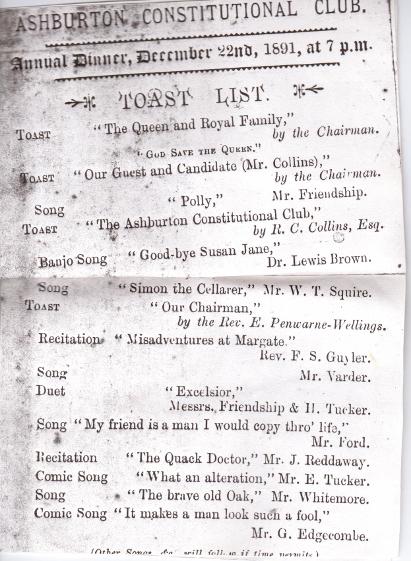
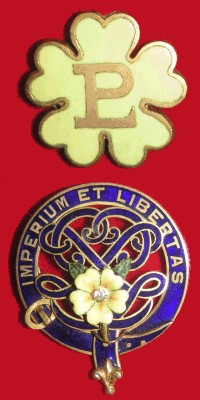
Following on from Primrose Day (see above) came the formation of the Primrose League, for admirers of Benjamin Disraeli and the principles of Conservatism and imperialism.
Left: Badges worn by members of the Primrose League, which was formed in 1883
Released under the GNU Free Documentation License.
Right: A letter from amongst the effects of the Misses Carter, who lived at 85, East St in the late 1900s. It was sent in 1929 from Reginald Bennett, of The Primrose League, to T Carter (their father ?)
T Carter had obviously had an idea on how to deal with the influence of Socialism. Mr Bennett replies "Emigration would do much to relieve conditions here and to develop Empire
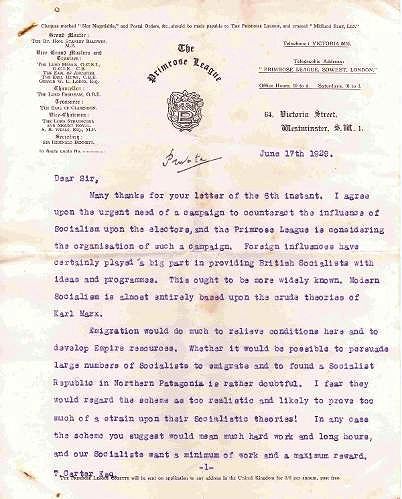
resources. Whether it would be possible to persuade large numbers of socialists to emigrate and to found a Socialist Republic in Northern Patagonia is rather doubtful...."
From my own collection
The Ashburton Choral Society
'He [Mr H O Jones] founded and conducted the choral society. Every year he presented a concert, with London artists
and the Royal Marine Orchestra. They were considered social events of
the year. Occasionally the parish church would be used and an oratorio
sung, for which the acoustics of our splendid church were well nigh
perfect.'
From the memories of Reg Andrews, born 1893.
Many thanks to Dave Hodge-Brooks and Ernie Smerdon.
1901 Charles Saunders, tenor, complimented Ashburton on the organization of its Choral and Orchestral Society.
Western Times 3 May 1901 p6 col1
The Ashburton Choral Society was in existence in 1925, with President the Rev Prebendary A H Thompson, and Vice-President H J Mason.
See the poster for a Grand Festival Performance in that year, in the 1920s section of the Virtual museum.
******
Clubs and societies in the 1920s
(In the 1920s) the vicar and his wife were greatly respected, the church providing activities for children and young people. Teenagers did not exist then. There was Sunday School, King’s Messengers, Boy Scouts, Girl Guides, Cubs and Brownies. The chapels had their organisations too, children belonged to Guides and there were numerous other activities. I remember being taken by one of my chapel friends to see a magic lantern show for the princely sum of two pence. The first slide showed waves beating against rocks, I can still visualise it! A quite serious discussion between my mother and aunt took place as to whether I should be allowed to accompany my friend, happily for me it was agreed that as it was not a service, just a slide show, it probably wouldn’t do me any harm! On my arrival home I was cross-questioned by my mother, she seemed satisfied that I had not been indoctrinated, the opening hymn “Hark, hark my soul” being one of her favourites. This shows the hostility and suspicion that existed between church and chapel.
Thanks to Hazel Bray for the above item.
*******
Ashburton Girl Guides, late 1920s.
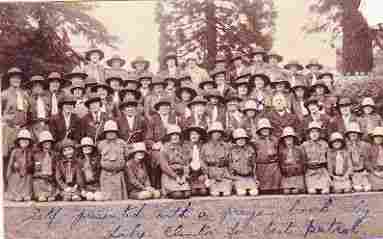
Left: Ashburton Girl Guides. Eileen Martin is in the 3rd row up from the front and fourth one in from the left. She was presented that day with a prayer book by Lady Clinton for best patrol.
Thanks to Christine Lunt for the photo and information

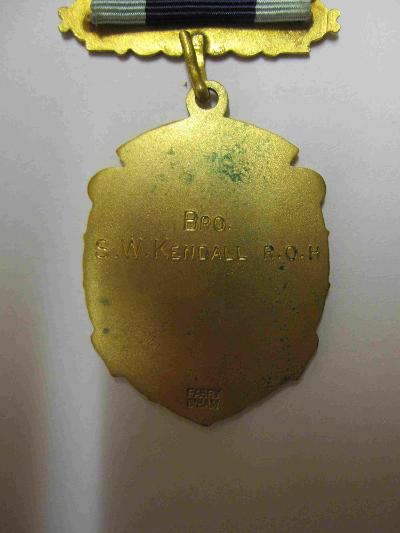
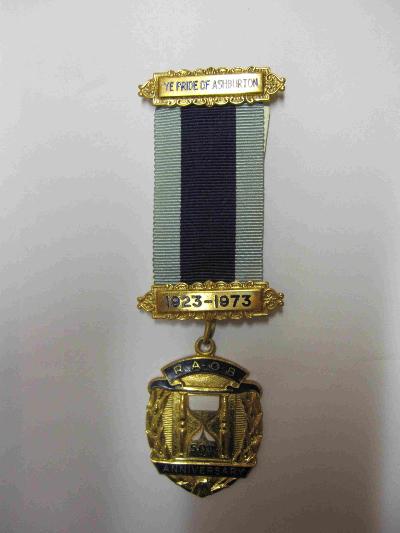
In 1937 'Ye Pride of Ashburton' Lodge held their third annual church parade. At this time the lodge had over 150 members.
Western Times 23 July 1937 p6 col2
**************
